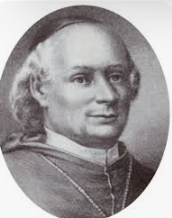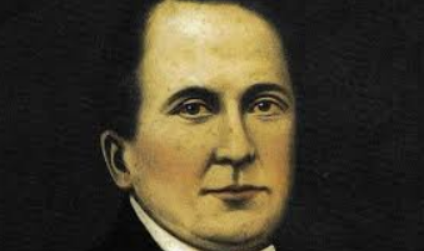Of Papal Provenance: The Catholic Impact on the History of Irish Nationalism.
The Dublin nationalist poet James Mangan penned the poem “My Dark Rosaleen” in the 1840s. The poem took on an outwardly romantic theme but its message was deeply nationalistic. So why the veneer of romanticism? Simple, nationalistic sentiment was outlawed in Ireland.
“Oh my dark Rosaleen,
Do not sigh, do not weep!
The priests are on the ocean green,
They march along the deep.
There’s wine from the royal Pope,
Upon the ocean green
And Spanish ale shall give you hope,
My Dark Rosaleen
My own Rosaleen!”
But who or what does "Dark Rosaleen" represent and what is this talk of ale, hope and marching? The answer?
Dark Rosaleen is Ireland and where she received aid from: Catholic Priests, the Papacy and the Empire of Spain.
Spanish aid to Ireland is well documented most notably at the Battle of Kinsale, where the Northern Earls, O’Neil and O’Donnell were defeated by English forces under Mountjoy, Christmas 1601.
Papal money, troops and advisors are however not as well documented nor as widely known but it is arguable, and it is this author’s contention, that Papal aid was more widespread, generous & prolonged than any other external supporter of Irish Nationalism bar none.
But on what basis do I make this claim and apart from a romantic mid-19th Century poet named James Mangan who or what else supports this author's claim?
Fusion of Catholicism and Nationalism
But first, a brief review of the “how” the fusing of Catholicism and Irish nationalism came about and what drove it.
Henry VIII was excommunicated in 1533 by the Pope. He initiated religious persecution against members of the Roman Catholic faith in the same year. In an Irish context this basically meant the entire Island was subject to persecution. The new belief system of "wokeness" anyone?
Marching alongside the war on the Catholic religion was the change in state policy adopted by the Tudor dynasty. The Tudor's desired to consolidate Royal power in Ireland around Dublin Castle. This policy directly threatened the Lords and clans of the "Old Irish" and "Old English" alike.
After the fall of the Fitzgeralds of Kildare, the most powerful of the Irish Lords, a gradual realisation spread across Ireland. Irrespective of how the individual lords conducted themselves, irrespective of how loyal they were, the new English establishment viewed them all as Irish Catholics and therefore, by extension, potential traitors. This narrative suited the Dublin Castle establishment. Using the "traitor" angle of religious beliefs it enabled the establishment to push through its policy of centralisation by either indirect (persuasion and compliance) and direct means (outright suppression).
This combination of religious persecution and curtailment of civil liberties, rights & privilege, helped accelerate the concept of nationhood amongst the Irish and fuse Nationalism with Catholicism.
Acts & Laws enacted
This growing realisation of Irish Lords was firmly rooted in fact. A series of laws and practices introduced by the Tudors and the Dublin Castle establishment that underpinned this realisation.
1. 1520s Start of Surrender and Regrant, Irish lords would give up Irish titles in exchange for new titles granted by the English crown. A forerunner of ceding national sovereignty, perhaps?
2. 1534 Treasons Act of 1534 defined even unspoken mental allegiance to the Papacy as an act of treason. Modern day Hate Speech laws and unforwarded memes on phones?
3. 1541 formal recognition of Henry VIII as "King of Ireland" as opposed to "Lord of Ireland"/ Rebranding of the EEC to the EU anyone?
4. 1551 Introduction of the "Book of Common Prayer" looking to regulate prayer in Ireland. Defining new "acceptable" speech and outlawing old outdated "unacceptable" speech. Todays' politically allowed speech and vocabulary?
5. 1556 Laois/Offaly planted. This, dear reader, I'll leave it up to you to draw any parallels you may see fit.
The ability to read and write in Ireland at this time was limited. Priests in addition to their religious duties also provided the skills of reading, interpreting and explaining what the new laws meant. Catholic priests played a pivotal role in acting as advisors to the Irish Lords. The establishment targeted priests outwardly for their religious beliefs but cynically to remove this source of advice from the Irish Lords.
2nd Desmond Rebellion 1579 to 1581
In July 1579 James FitzMaurice FitzGerald, Captain General of Desmond landed in Kerry with a force of Papal soldiers. On his landing he raised the Papal flag, calling upon the Irish to join him both to defend Catholicism and to restore lands lost to the English. In so doing FitzMaurice became the first significant leader of an Irish rebellion to specifically link Catholicism to the wider struggle against the English crown.
9 Year war 1594 to 1603
He was not the last. Hugh O'Neil in the 9 year war also called on the Irish to fight to defend Catholicism and in his peace overtunes to the Earl of Essex, Lord Lieutenant of Ireland, he insisted on rights to Catholic religious freedom. Both O'Neil and FitzMaurices vision for an Ireland free of English rule was an independent Irish Kingdom ruled by a Catholic Habsburg.
11 Year war 1641 to 1652
The first real national effort to enact an Irish parliament, the Confederation of Kilkenny, was driven largely by Catholic clergy, continuing their role of advisors to Irish Lords. This formal parliament built on Hugh O'Neil's informal confederacy of Irish Lords in the 9 years war. Owen Roe O'Neil achieved a stunning total victory at Benburb 1649. The victory was in part to O'Neil's gifted generalship but also due to the arms, ammunition and crucially money that allowed for the training of O'Neil's Ulster army. Who supplied the funds, arms and ammunition? The Papacy routed through the Papal Nuncio Rinuccini who personally accompanied Owen Roe.
United Irishmen 1798
Father Murphy provided direct leadership of the Wexford rebels. He led the ill-armed and undisciplined croppies to victories at Oulart Hill, Enniscorthy & Tubberneering . His forces took the key towns of Enniscorthy and Wexford itself., before failing at Arklow. Father Murphy was tortured and hung. But Father Murphy was far from the first priest to command Irish nationalist forces.
Bishop MacEgan opted to die when he was hung using the reins of his own horse outside the Castle of Carrigadrohid, Cork in 1650. He refused to call upon the castle garrison to surrender in exchange for his life. He instead urged the garrison to fight on. Bishop MacMahon, long time advisor to Owen Roe O'Neil, and commander of the Army of Ulster on O'Neils death, was likewise hanged in 1650 on the opposite side of the Island in Donegal. He was beheaded after his hanging out of both malice and relief.
To travel full circle back to Henry VIIIs time, one Father Travers was burnt at the stake in 1535 in Smithfields Dublin. His crime? He advised and counselled the Geraldines of Kildare during their failed rebellion against the Tudor policy of centralisation of Royal Power.
Conclusion
It is these men of God that James Mangan referred to when he used the immortal line of "the priests are on the ocean green, they march along the deep''. Many more men of God marched alongside the forces of Irish Nationalism, after Mangan's time. From the social wars of the 19th Century (Tithe War, Emancipation & Land Wars) to the direct action of the Young Irelanders, the Fenians, the IRB and finally the IRA.
During the War of Independence, one Father Griffin was taken from his home in Galway in 1920. One week later his body was discovered in a bog riddled with bullets. His crime? Open support of the IRA. British army records detailed the activities of 71 priests who actively aided and abetted the IRA. Out of the entire Catholic clergy in Ireland at this time only 4% condemned the IRA. The other 96% directly or indirectly supported the IRA. Activities like fundraising, giving moral and spiritual support to the IRA and serving on Sinn Fein courts were commonplace.
Historically, Irish Nationalism and Catholicism have marched hand in hand. These two key principles of Irish nationhood were forged in the fire of Royal British & Dublin Castle oppression. Clergy and laymen alike fought and died together to see Ireland take her rightful place in the nations of the World.
We should not forget.





